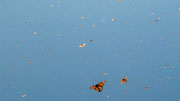 Universalism is back—at least in social-democratic redoubts like Barcelona (where MACBA’s “Universal Archive” opened last winter) and now Toronto. No longer conjured from the imagined ubiquity of the commodity form and its reflexive overcoming in distributed human reason, universalism is now being drawn from that same centerlessness of raw data and blind code that once seemed fated to the dark netherworld of the postmodern. “Universal Code” makes its case for this renewed promise with works by some 15 artists, including Angela Bulloch, Mircea Cantor, Cerith Wyn Evans, Gabriel Orozco, and Michael Snow. Pegged to the International Year of Astronomy’s celebration of the 400th anniversary of Galileo’s and Kepler’s signal accomplishments, the show works to reunite the deadened instrumental certainty of universal bar codes and the like with an older living, breathing philosophical inquiry into a universal code of ethics. |
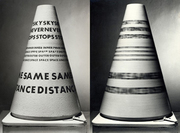 Decades ago, Joseph Kosuth famously dismissed young upstarts like Vito Acconci as doing “concrete poetry,” not true Conceptual art. But the visual experiments with language made by such progenitors of the genre as Augusto de Campos, Eugen Gomringer, and Emmett Williams nevertheless filtered out into the art world, where, perhaps to Kosuth’s dismay, they firmly took root. Titled after the 1960s literary journal founded by Scottish artist-poet Ian Hamilton Finlay, “P.O.T.H.” looks back at this tradition through a contemporary lens to assemble a diverse array of poetic, typographic, and textual works, from wall painting to sculpture, by nearly twenty artists and writers, including Carl Andre, Ferdinand Kriwet, and Frances Stark. A dedicated publication of text-based work will accompany the exhibition. |
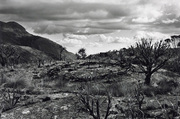 Following hard on the heels of Long’s 2007 Scottish National Gallery of Modern Art survey, this major retrospective is the artist’s first large-scale show in London in nearly twenty years. Curators Helen Little and Clarrie Wallis have assembled about eighty of Long’s stone sculptures, expansive mud wall drawings, photographs, and text-based pieces to trace the development of his practice, from early, iconic land interventions such as A Line Made by Walking, 1967, to new work. Significantly, the venue—Tate Britain, as opposed to Tate Modern—could lead visitors to a lazy view of Long as an English pastoralist. However, the show’s scale, Long’s formal diversity, and his perspicuous responses to encounters with nature and culture should allow for that reading to be countered, suggesting a far wider reach and relevance to his practice. |
 Just in time for Popeye’s eightieth birthday, the Serpentine unveils a survey of Jeff Koons’s work dedicated to the Depression-era spinach guzzler. Although 2008 alone witnessed major Koons shows in Chicago, New York, Berlin, and Versailles, this will be the artist’s first museum exhibition in London and the first comprehensive look at the ongoing “Popeye” series of sculptures and paintings, begun in 2002. The titular sailor stars in but a few of these works, which are more frequently populated by inflatable animals and a bodacious Playboy bunny. While the lustrous, candy-colored icons from “Celebration,” 1994–, may have captured the lion’s share of Koons’s recent public attention, the lesser known “Popeye” series comprises some of his most inventive oil paintings and trompe l’oeil sculptures, which take his abiding preoccupation with the readymade to mind-boggling new heights. |
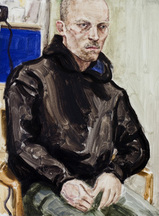 What becomes a legend most? In the 1970s, Lillian Helman clad in a Blackglama mink did the trick. Nowadays, the grandest compliment that fine art pays to glamour and celebrity might be Elizabeth Peyton's portraits. In a rather different but perhaps no less resonant way, Peyton is as much a signature artist of the '90s as Matthew Barney, the subject of a recent Peyton portrait—and, given her proclivity for skinny, languorous, seemingly lipstick-besmirched ephebi, an uncharacteristic one. Bringing together more than one hundred works, the New Museum surveys fifteen years of the artist's career. The catalogue includes essays by curator Laura Hoptman, Iwona Blazwick, and poet and superearly Warhol icon John Giorno. |
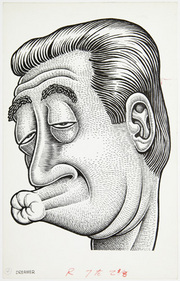
What do Miss Bedney Flunt, Miss Fludney Bent, Miss Flentney Bunt, and Miss Blentney Funt have in common? Unreasonably odd proboscises and the hilarious misfortune of being drawn by Basil Wolverton. An artist and writer of sci-fi and humor comics from the 1930s through the ’70s and an alum of Mad magazine in subsequent decades, Wolverton showed a consistent partiality for screwball portraiture, and the nearly 150 works in this exhibition constitute “a ghastly gang of goops” (to borrow a phrase from the artist himself). His mid-’60s sketches of illogically deformed heads for Topps chewing-gum cards (one could plan a show simply around the who’s who of cartoonists—including Art Spiegelman, Kim Deitch, Drew Freidman, and Bill Griffith—who have created art for Topps) rank among the show’s most outlandishly gruesome pieces. In fact, Wolverton’s intricate, often dense hatch work and nutty caricatures anticipate much of the cracked subversion of ’60s underground comix, Crumb’s textured satires in particular.
A thin line exists between Wolverton’s jokey grotesqueries and the horrors of disfigurement and mutilation that appear in his postwar illustrations of the Book of Revelations (recently published in The Wolverton Bible). The carbuncle-covered figures in Plague of Darkness with Boils, ca. 1950, for instance, bear resemblance to a host of heinously rendered Mad readers drawn four years later. Wolverton’s unsparing depictions of nightmarish prophecies are relentlessly grim but absorbingly so. There are hints of Goya’s crazed, melancholic Saturn and predictions of Charles Burns’s brooding mutant teens. In most of the biblical drawings on view, men and women are, if not the immediate focal point, very much the purpose. Such humanity is everywhere in Wolverton’s art—as much in the laughably goony portraits as in the fire-and-brimstone ferocity. |
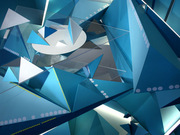
This gallery’s glowering, barnlike space presents its visiting curators with a stiff formal challenge, but Felicity Hogan has grabbed the bull by the horns in assembling a richly tactile five-person group exhibition on the broad theme of extropy, or the gradual distillation of chaos and complexity into fundamental essence. Hogan’s selected artists—all women—employ a catholic range of media and formats but stick resolutely and productively to the abstract in probing the innumerable possibilities of visual and material systems. Emerging from a sea of summer shows teetering on conceptual premises doomed by either willful obscurity or ham-fisted obviousness, “Structured Simplicity” distinguishes itself with a bracing concentration on shape, color, texture, and—in the case of Amy Yoes’s hypnotic video loop Modification and Collapse, 2009—movement and sound.
Mai Braun’s Pile II, 2009—a mass of shredded copies of the New York Times bound up with string—is the most direct embodiment of the show’s premise, but her Tower—Fragile to Clorox, 2006, a stack of cardboard boxes cut and remodeled into crystalline facets, is ultimately a more satisfying transformation. Hilary Harnischfeger makes use of real crystals, integrating chunks of quartz and zeolite into multilayered constructions that look more unearthed than assembled, while Elana Herzog’s Untitled #1 (chainlink drapery study), 2004, a cotton-chenille bedspread stapled to the wall then partially ripped away, also seems to inhabit a hinterland between the organic and the artificial. Last—and best—the eccentric biomorphism shared by Fabienne Lasserre’s half dozen combinations of felt, ceramics, linen, and pigment, as well as acrylic polymer and paint, finally flips the whole interior from enclosure to environment. |
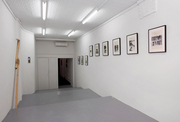
The only witness to Jiří Kovanda’s 1977 act of scooping debris into a pile and scattering it again was his friend Pavel Tuc, whose photograph of a moment in the process is a trace of this private and eccentric performance. Kovanda’s labels for such documents describe the contents of his actions, and place the photographs in brief, droll narratives. Those displayed at Ludlow 38 include I carry some water from the river in my cupped hands and release it a few meters downriver . . ., 1977, and I arrange to meet with several of my friends . . . Suddenly I started to run, 1978. The exhibition also includes works by Július Koller made in Bratislava around the same time. A cutout from a photograph of a landscape is shaped like a flying saucer and tilts menacingly, while diagrammatic drawings on postcards variously expand on the acronym UFO with words like UTOPIAN, UNIVERSAL, OBSERVATION, and FUTURIST. Koller and Kovanda are split between two rooms, but—in a curatorial flourish resonant with the artists’ works—a stray piece by each hangs out of bounds. The juxtaposition of the two encourages a comparison between disturbances in two types of environments, urban and verbal. Koller’s use of the flying saucer as the embodiment of the non sequitur accentuates Kovanda’s choice to be an alien in his own city.
Amid the selection of photographs and documents, an assemblage of two wooden boards roped together and inserted between two corners of the front gallery is the only work with heft. Kovanda made it for Ludlow 38. It demonstrates that his interventions extend beyond performative actions, as do two concurrent solo shows in Chelsea on view until August 14. Andrew Kreps is showing his drawings and collages from the 1970s and ’90s, so slight they are little more than traces of the artist’s touch on the paper, while a new installation at Wallspace measures the gallery’s perimeter with a rope strung along the wall. The endurance and consistency of Kovanda’s art suppresses the temptation to read his or Koller’s work as a politicized chafing against Czechoslovakia’s socialist bureaucracy. Like other contemporaneous Conceptual artists, Kovanda and Koller confronted prescribed patterns of living and thinking to explore other ways of being. |

The centerpiece of Raymond Pettibon and Yoshua Okon’s exhibition mines the mythic history of Los Angeles’s cultural past. Flanked on both sides by individual works by each artist, Hipnostasis, 2009, is a jointly produced six-channel video installation that provides an intimate glimpse into the interior lives of six anonymous beach bums as they silently consume steaks on the rocks of Venice Beach at daybreak. Pettibon and Okon’s practices merge here for the first time to form a quiet document of a bygone era of the Venice Beach vanguard. The portraits that make up Hipnostasis focus on individual hippies who have formed communities and have remained in the area despite its transformation into an upscale neighborhood and popular tourist destination. Persisting as a remnant of the city’s unofficial history, the decaying bohemian icon enters into Pettibon and Okon’s project as the subcultural ideal, as the anachronistic embodiment of political nonconformity to the point of primitivism. Interspersed around the six flat-screen monitors, Pettibon’s scrawled textual fragments refer further to the characters and histories that have shaped the myth of the itinerant artist as the sordid alternative to the city’s lighter and sunnier past. Names and places like SWAMI X and SYNANON emerge from the hurried writing to form an unofficial history of the currents that flow along the region’s underside. Individual and collective figures of the revolutionary and the exotic other have separately occupied the attention of Pettibon and Okon throughout much of their careers, and their collaborative project represents the manifestation of these archetypes in the form of the Venice Beach hippie as a pervasive marker of cultural and historical disruption. |
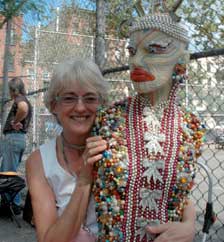
ON A SUNNY SATURDAY MORNING IN JULY, the art-world version of A Chorus Line (“I hope I get it!”) snaked around the streets surrounding White Columns in the West Village. Hundreds of artists—each “one singular sensation”—showed up to an open call for the “untitled art project” now casting by Bravo. Sarah Jessica Parker’s production company is teaming with Magical Elves (Top Chef, Project Runway) to do for contemporary art what those other shows have done for food and frocks. All morning (some arrived at 1 AM), the slow-moving line maintained its crazy length as latecomers arrived and replaced the early birds. (A total of twelve hundred had already been screened in Chicago, Miami, and LA.)
Instead of hoofing and singing, they schlepped portfolios, laptops, and samples of their work. One toted a life-size painting of himself as Saint Sebastian pierced by arrows. The “Walking Art Museum” lady was an adhesive gabber from “near Philly. For now. I’d love to be here. I need to divorce my husband and find a rich guy,” she chuckled with Phyllis Diller–like bravado. She’d hauled her objets on the subway: A pink plastic scooter bore a mirror and trinket-encrusted mannequin torso, plus other items festooned with mirrors, faces, beads, and doll parts. A live topless chick in a G-string was a painting in progress—and a cheesy attention-getting device—for the chap who intently daubed away at her in blue while she passed out his business cards.
Along with the oddballs, the outsider naifs, and the boring juried-art-show types (both representational and abstract), there were a handful (among those I randomly chatted with) who had something going on. A cute young couple from Brooklyn were there, hoping—like everyone else—to quit their day jobs: She was a Russian-born “subversive knitter” (and graphic artist by day); he was from Utah and made “satirical portraits of Mormon patriarchs” that were a bit Peter Saul–esque. From Boston, a wit who had answered “Scott” on the questionnaire when asked to describe himself in one word had an equally apt business card: I PAINT ASTRONAUTS AND SOMETIMES, DINOSAURS. Which he did, quite amusingly.
As I scanned the line, the sight of all that hopefulness, vulnerability, and probable rejection was poignant. Rejection happens all the time in the art world, but it’s rarely so visible. Like puppies in an art pound, everyone made eye contact, eager to pitch: It was a primal display of “putting yourself out there” denuded of any social foreplay. As someone who identifies too well with people about to have their bubble burst, I marveled how actors have to do this all the time.
“You should do it as a piece,” said photographer Ryan McNamara’s friend when they heard about the show. “Hmm, a piece about being a fame whore . . . Isn’t that already built into being an artist?” he riffed.
Were they looking for good artists or for people who’d make for good reality TV? A self-aware person’s not going to be a clown, and cluelessness and telegenic meltdowns are key to the genre. In a brief chat, casting director Nick Gilhool emphasized that they are indeed going for art-world cred here: They’re involving “art professionals and luminaries whose names you would recognize. It’s kind of a cloistered community, and we’re bringing that into kind of a pop-culture setting.” When I wondered how this would translate for TV, he observed: “If you have some legs (as an artist) you’re gonna be an interesting person—that sort of takes care of itself.”
Most details about the show are either top secret or not yet decided. We do know that auctioneer Simon de Pury will be one of the “art-world luminaries” involved, and taping will begin this fall. Each applicant filled out a probing questionnaire that was like a year’s worth of therapy in thirteen pages (“What would someone close to you describe as your best and worst traits?” “What makes you nervous?”); a draconian nondisclosure agreement would demand one million dollars–plus for any breach of confidentiality. Press was forbidden to approach anyone after they’d been screened or G-d knows what would happen. The psychic root canal of the questionnaire plus potential financial penalties mingled fond hopes of Cinderella-like art stardom with a Foucauldian whiff of disciplinary regimes and clinics. Nevertheless, the mood was upbeat, if slightly abashed, on the line, buoyed by the random camaraderie of mutual vulnerability and the subterranean buzz of ambition, however insane.
Most were philosophical: “Just another thing, another marketing thing,” said another “encruster,” an ex-model from Bridgeport. “Life is a spectacle to begin with, so why not?” mused a photographer who’d flown in from Dallas. One applicant, Lulu, was so certain she’d be picked she’d already quit her job working with seniors. A warm gal exuding a “school of hard knocks” vibe, she came in on the bus from Boston the night before. From a bulging black portfolio, she pulled several framed portraits of women. “This one’s for the Jews.” She eyed me intently as I wondered if I’d heard her right: “My Holocaust piece.” It depicted a gray hand on a plump, flesh-colored breast: “The hand of Germany. Black and white. Cold and dead. The breast represents life.” Oy. “One singular sensation,” indeed. |
|
| Statistics |
Total online: 1 Guests: 1 Users: 0 | |









